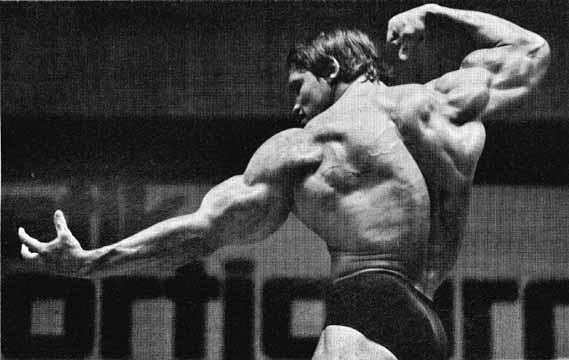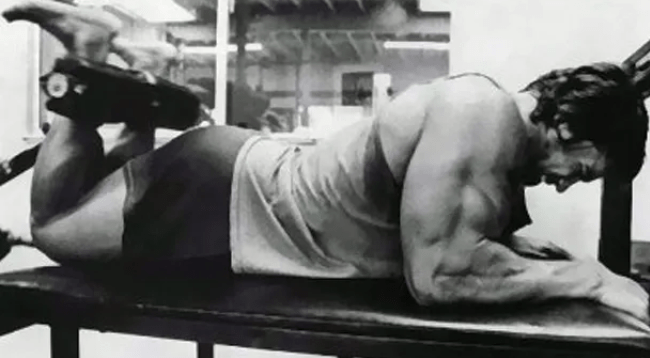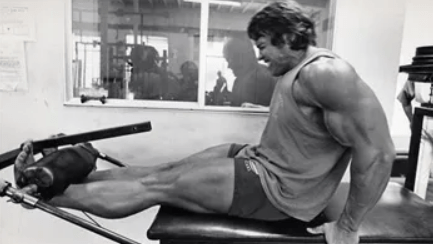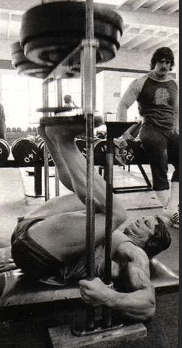After his initial first years of training, Arnold Schwarzenegger was already a rising star of the Europe bodybuilding scene. Young weightlifting champion at a mere 15 years old, tried his hand to powerlifting too and owned the deadlift german record for 2 years at only 20, Arnold was a freakishly big and strong guy at the time. His focus aimed at high level bodybuilding, especially after meeting his idol Reg Park. his training approach, who had been a powerbuilding training approach, had to evolve too.
Indeed, in 1968, a gigantic, 113.5kg/250lbs, top heavy Arnold lost to a “17” arms chicken”. That “chicken” was none other than Frank Zane, way smaller and shorter (by about 22kg/50lbs), but incredibly tanned and built, everything well proportioned and defined. At that moment, Arnold understood his quest for sheer size had to end if he ever wanted to become the best.

Frank Zane shook the stage with his deep tan and defined physique
But before the golden 70’s, the workout under the Venice Beach sun, and the businessman venture, Arnold’s mass was his win card, and that’s what made him so great as an athlete, even in his peak years. Humongous pectorals on a thick and wide ribcage ? Check. Mountain like biceps ? Check. Lats so wide they block the sun ? Check.
What kind of training would have put so much mass on an already impressive frame ? Let’s find out.

Arnold at 20 already showing outstanding size and mass, but still a diamond in the rough
Arnold Mass Plan : the Powerbuilding Training approach
Like most young athletes, Arnold wanted mass, and fast. For that, no reason to go look further than Powerbuilding Training. It is essentially a focus on a few key compounds movements where you want to improve as fast and as far as possible strength wise, which will result in new muscle tissue.
Indeed, mechanical tension is one, if not THE muscle hypertrophy driver, which mean that the stronger you get, the easier it is for you to get big. And at the same time, the more the muscle fibers are thicker, the easier they can generate torque and force across one or several joints, meaning, the bigger you are, the stronger you can get. Killing two birds in one stone as we say, or a total win-win if you prefer.
Practice wise, we focus on usual all-time king exercises that are squats, deadlifts, bench press, overhead press and also dips and chins, and we just get stupid strong at them. Add in some isolation for balance, weak point bring up and injury prevention, and you got the typical top athlete Powerlifting/CrossFit/Bodybuilding/general strength gym bro programming. For you, it is logical and totally normal, in the 60’s, that wasn’t mandatory.
Take in the fact that bodybuilding itself was a very niche and even sect-like sport and endeavor, it is no surprise it kept improving and reinventing itself before coming to the highest amount of specialization, application and knowledge possible we see nowadays.
Even though Arnold don’t have a strong guy reputation, for someone that never focused or peaked in the strength department, his performance record is astonishing :
- Clean and Press : 120kg/264lbs
- Clean and Jerk : 135kg/298lbs
- Snatch : 110kg/243lbs
All of these lifts were recorded at the 1965 Austrian Olympic Weightlifting Championship in the heavyweight class, at a mere 18 years old. From 1966 to 1968, he would also try his hand to powerlifting, and get his total from 545kg/1200lbs to just under 727kg/1600lbs in 18 months. His best recorded lifts in competition at only 20 years old are as followed:
- Squat : 215kg/474lbs
- Bench Press : 200kg/440lbs
- Deadlift : 310kg/682lbs
Imagine if he had focused on one or the other sport what numbers he could have showed a decade or so later on ? During the following years, Arnold would pull off others impressive feats in training as well, even if his strength sport days were over afterward.
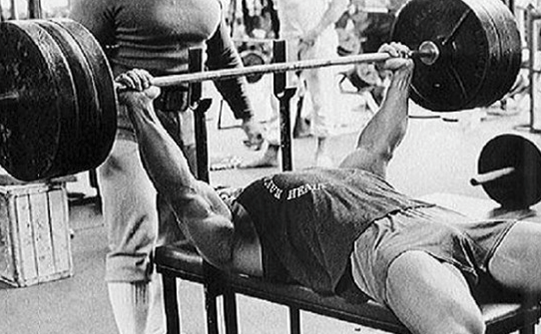
When you can toy with a 3 plates bench in training, you know you did something right
This type of story is much common nowadays, where weightlifters and powerlifters turn to bodybuilding or crossfit, or when the reverse happens, like Stan Efferding, Johnie Jackson, Ronnie Coleman or even Dmitri Klokov. But Arnold was actually one of the first to create a path thousands if not millions took and keep taking to this day.
Now, let’s see how he planned and did it.
Arnold “How to Gain Muscular Weight and Massiveness” Pamphlet
Just like many silver era athletes of that time, the go-to routine when you want to get as big and strong as fast possible was Full Body Training. Three times a week, three sets per exercises, 6 to 12 total exercises.
Whatever you say, heard or read somewhere else about how bad and “suboptimal” these are, 90% of athletes you see in pictures from the 30’s up to the 60’s were doing it, and they are all to this day still, peak aesthetic and muscular development for natural athletes. Only a few of them then transitioned to Half Body for better recovery and frequency as they got stronger, or even Split Body Training, like Arnold himself, and anabolic steroid introduction in the sport as well as the Weider’s heavy influence on the ads and content at the time were some of these reasons.
If you are natural, not advanced yet strength wise, and don’t want to spend 6 days a week in the gym for 2h, you already got three good reasons to do Full Body Training. That’s what I did for years, still do occasionally and what most of my trainees are doing.
Moving on, here is the powerbuilding training plan :
- Squat
- Bench Press
- Incline Press
- Wide Grip Pull Up
- Bent Over Row
- BTN Press
- Curl
- DB French Press
- Deadlift
- Calves Raises
His guidelines are as follow : warm up first with 2×8 while increasing the weight. Then, for your working sets, do 3×6-8. For Deadlift, keep ramping-up to a top set of 6-8 reps, and for Calves, increase the reps range to 15-20. That’s it. Simple, brutal, effective.
At that time, most of the training programs were either in the 3-5 reps range, or 8-12. We had some variations of the 5×5 Training, but the 6-8 range was rarely incorporated and exploited. Arnold’s powerbuilding training gave him a good balance of total training volume, but also, an easier way to use heavier poundages. The influence of Reg Park and his trainer of the time, a bodybuilding judge and coach, sir Charles “Wag” Bennett are pretty visible.
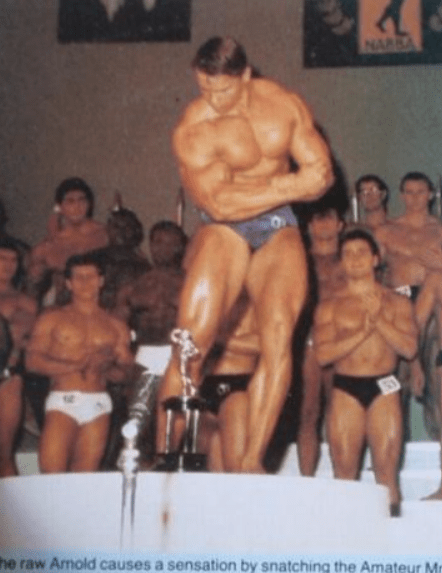
20 years old Arnold already humongous, snatching Mr.Europe and Mr.Universe Amateur titles left and rights
Arnold’s Powerbuilding Training Review
As a double certified personal trainer and sport nutritionist, natural bodybuilding champion and with more than a decade of training, I know a thing or two about it.
The first thing I want to address is the fact that, as a Full Body Training lover, a thrice a week schedule like that makes me get a pump just by looking at it. The whole body is more or less worked, even if of course, we can do some nitpicking.
Compared to his Golden Six Full Body Training, there are a lot of improvements : more pressing and pulling variations, triceps isolation included, deadlifting and calf work.
However, this powerbuilding training program is a telltail sign of what made Arnold’s strong points so great, and what made his weaker bodyparts so weak : training balance.
You see, Arnold’s legs, especially his calves, were a plague for him most of his training career. It was both an issue of not training them hard enough at first, and then playing catch-up, but also, limited training equipment at the time. Indeed, apart of dumbbells, barbells and cables, you didn’t had much more in the 60’s to build your body.
Later on, especially in the late 70’s and early 80’s, Arnold would be very adamant on using the Smith Machine for his squatting, bench, incline and even overhead pressing, to limit the wear and tear of the joints. In the 70’s, his leg training contained every single machine he could use at Gold’s Gym, like the leg curl and extension ones but also a rudimentary vertical Leg Press machine.
Thus, not enough leg training early on (for him and most likely you) would be an issue. The second problem that could arise is the huge amount of pressing movements per session. Nine sets of heavy pressing, three times a week, from very hard exercises on the shoulder won’t be kind to your joints. Decreasing the volume a bit, or removing one exercise since frequency and intensity are the focus and already quite high isn’t an issue at all. Less to recover from, more fuel to build muscle and move iron.

If Arnold wasn’t afraid to use the Smith, neither should you
Same thing for his shoulders, who were droppy and small compared to his gigantic torso and arms; of course the look was intentional, as it is part of the Golden Era aesthetic, but this lack of balance is also responsible for most shoulder issues and injuries. More rear delt and external shoulder rotator work would prehab that very simply.
Finally, the low back fatigue isn’t properly managed either. Back Squat, then later on Bent-Over Row, then Deadlifts ? Again, thrice a week ? Ouch. Lumbar spine and erector spinae at that spine region are already pretty slow to recover and easy to get beat up, this won’t help at all. With better exercises selection and order, it is an easily avoidable issue.
Also, last point, this whole routine is repeated thrice a week. That’s a shortcut to overuse injuries, nagging pain and joint discomfort. Rotating variations every two, three, or even four weeks, or, having a different session each training day would greatly reduce these risks. Nothing keeps you from taking two days of rest if you feel too beat up either.
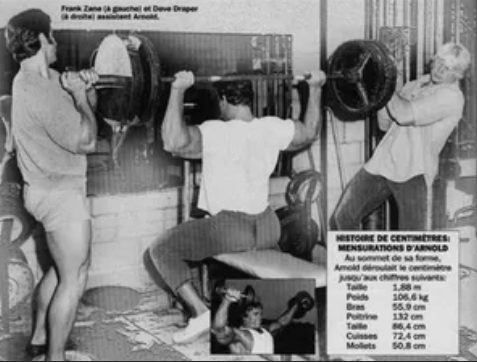
3 Plates BTN Press on the menu, no support, no rack, no safety pin, what is your excuse ?
Arnold’s Powerbuilding Training Revisited
Here is the Powerbuilding training template I reworked and how I would have set up. As a reminder, I keep in mind the time period and available equipment, most, if not everything of what I propose can be replaced by machines in a bodybuilding focused context. We are here to better grow, with less risks and worries about our body’s health after all.
Full Body A (his sample training revisited):
- Back Squat : 3×6-8 (to parallel, heels elevated)
- Bench Press : 2×6-8 (medium grip)
- Incline Press : 2×6-8 (wide grip)
- Wide Grip Pull Up : 3×6-8 or 50 total reps at BW in as little sets as possible
- Bent Over Row : 3×6-8 (torso bent around 60°)
- BTN Press : 3×6-8 (seated, back braced against bench)
- Barbell Curl : 3×6-8 (use slight momentum at beginning to avoid elbow stress, EZ bar if wrist discomfort)
- DB French Press : 3×6-8 (use a back support and slight torso incline)
- Deadlift : sets of 2-8 reps until 1×6-8 top set with touch-and-go style
- Calves Raises : 3×15-20 (pause 1s at top and bottom)
Full Body B :
- Close Grip Bench Press : 3×6-8 (use shoulder width grip or slightly closer)
- High Incline Press : 3×6-8 (bench around 60°)
- Neutral Grip Chin Up : 3×6-8 (weighted) or 50 total reps at BW in as little sets as possible
- Chest Supported Row : 3×6-8 on a 30° incline bench, pause 1s at top, elbow out
- Rear Delt Flyes : 3×12-15 lying on a 30° incline bench
- DB Seated Curl : 3×6-8/arm, keep form as strict as possible, use slight pause at top
- EZ Bar Pull Over Triceps : 3×8-10, lower under control, shoulder width grip or so
- Front Squat : 4×5-8, as deep as possible
- Dumbbell Romanian Deadlift : 2×15-20
- Seated Calves Raises : 3×15-20 (pause 1s top and bottom)
Full Body C :
- DB Bench Press : 2×6-8
- DB Incline Press : 2×6-8 bench around 30-40°
- Sternum Pull Down : 3×8-10 pause 1s bottom
- DB Bent Over Row : 3×8-10/arm, pulling to chest/upper abs in straight line
- Wide Grip Upright Row : 3×6-8, retract and shrug the scapulae, use slight momentum at beginning
- DB Hammer Curl : 3×6-8/arm, slight pause at top to avoid cheating
- Dips : 3×6-8 (weighted) or 80 total reps BW in as little sets as possible
- Squat : 1×5-8, 1×15-20 (heels elevated, as deep as possible, Breathing Squat Style for the second set)
- Stiff Legged Deadlift : 1×15-20 touch and go
- Donkey Calf Raises : 3×15-20 (pause 1s top and bottom)
And there you have it !
Simple, brutal, effective. It isn’t perfect, pretty generic, and very easy to modify. Still, the Powerbuilding Training approach is there and we got something way less dangerous and tiring than before.
I hope you enjoyed this article, and that it gave you both motivation and insights for your own training. You can always reach out and check out my services if you want my help, I will be happy to help.
Take good care, and like the Austrian Oak said : “The resistance that you fight physically in the gym and the resistance that you fight in life can only build a strong character.”
Hersovyac.

